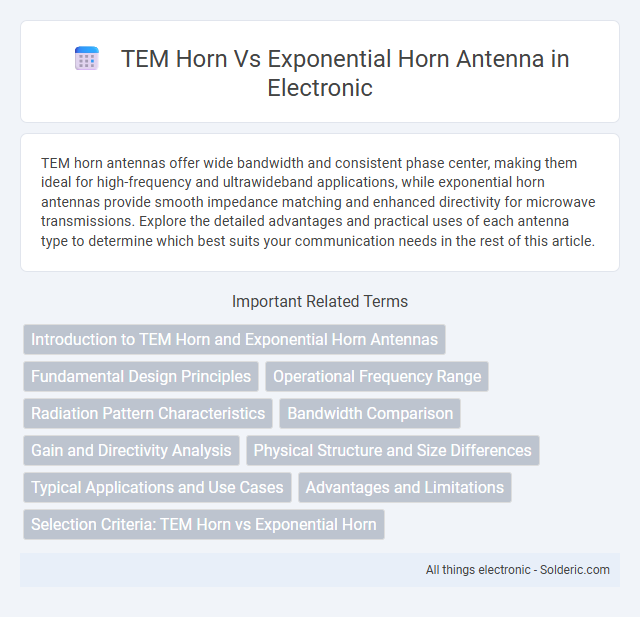TEM horn antennas offer wide bandwidth and consistent phase center, making them ideal for high-frequency and ultrawideband applications, while exponential horn antennas provide smooth impedance matching and enhanced directivity for microwave transmissions. Explore the detailed advantages and practical uses of each antenna type to determine which best suits your communication needs in the rest of this article.
Comparison Table
| Feature | TEM Horn Antenna | Exponential Horn Antenna |
|---|---|---|
| Frequency Range | Ultra-wideband (UWB), typically 100 MHz to 18 GHz | Wideband, typically 1 GHz to 40 GHz |
| Radiation Pattern | Stable, directional with low sidelobes | Broad main lobe with moderate sidelobes |
| Gain | Moderate gain, 6-12 dBi | Higher gain, 10-20 dBi |
| Impedance Matching | Excellent broadband impedance match | Good impedance match over operating band |
| Physical Size | Relatively compact for UWB applications | Larger size due to gradual flare shape |
| Applications | Time-domain measurements, EMC testing, impulse radar | High-frequency communication, radar, satellite |
| Construction | Parallel plate structure with tapered edges | Flared metal waveguide with exponential profile |
| Directivity | Moderate directivity | Higher directivity |
Introduction to TEM Horn and Exponential Horn Antennas
TEM horn antennas are characterized by their tapered, parallel-plate structure that supports transverse electromagnetic wave propagation, offering low dispersion and wide bandwidth ideal for high-frequency applications. Exponential horn antennas feature a smoothly flared profile that exponentially expands the aperture, improving impedance matching and reducing side lobes for enhanced radiation efficiency. Choosing between these antennas depends on Your need for bandwidth, directivity, and radiation pattern control in microwave or millimeter-wave systems.
Fundamental Design Principles
TEM horn antennas employ a two-conductor transmission line structure designed to support transverse electromagnetic wave propagation, providing broad bandwidth and low dispersion. Exponential horn antennas use a flare profile that expands exponentially from the throat to the aperture, optimizing impedance matching and minimizing reflections over a wide frequency range. The fundamental design principle of the TEM horn is maintaining uniform TEM mode, whereas the exponential horn focuses on smooth impedance transformation through its shaped geometry.
Operational Frequency Range
TEM horn antennas typically operate effectively across ultra-wideband frequencies, ranging from 0.5 GHz to over 20 GHz, making them suitable for applications requiring broad frequency coverage. Exponential horn antennas are designed to provide smooth impedance transition and perform best within a narrower, mid-frequency range, commonly between 1 GHz and 10 GHz. Your choice depends on whether you need ultra-wideband performance or optimized gain and beamwidth within a specific operational frequency range.
Radiation Pattern Characteristics
TEM horn antennas exhibit a well-defined, symmetrical radiation pattern with low side lobes, providing robust directivity and broad bandwidth ideal for radar and EMC testing. Exponential horn antennas generate a smooth, gradual flare resulting in a stable, low-distortion main lobe that enhances gain and reduces pattern ripples at higher frequencies. Your choice depends on whether you prioritize ultra-wide bandwidth with consistent radiation or a more controlled beam shape with increased gain.
Bandwidth Comparison
TEM horn antennas exhibit broader bandwidth capabilities, often achieving multi-octave frequency coverage essential for ultra-wideband applications, while exponential horn antennas provide moderately wide bandwidth but typically with narrower frequency range. The gradual exponential flare in exponential horns results in better impedance matching at specific frequency bands, enhancing gain but limiting overall bandwidth compared to the sharper flare transitions in TEM horns. Optimal bandwidth performance in TEM horns makes them suitable for high-frequency radar and communication systems demanding wide spectral response.
Gain and Directivity Analysis
TEM horn antennas typically offer higher gain and more uniform directivity across a wide frequency range due to their broadband nature, making them ideal for applications requiring consistent performance. Exponential horn antennas provide smooth impedance transformation and moderate gain, with directivity that improves at higher frequencies but may exhibit more variation across the band. When choosing between the two, consider that your system's gain and directivity requirements at specific frequencies will determine the better antenna type for optimized performance.
Physical Structure and Size Differences
TEM horn antennas feature a parallel-plate structure that produces a transverse electromagnetic wave, typically resulting in a larger physical size due to the broad aperture needed for wide bandwidth performance. Exponential horn antennas have a smoothly flaring profile that expands exponentially, allowing for a more compact size while maintaining efficient impedance matching and directional gain. Your choice between the two depends on the size constraints and the specific frequency range requirements of your application.
Typical Applications and Use Cases
TEM horn antennas are widely used in ultra-wideband radar systems and electromagnetic compatibility testing due to their broad bandwidth and consistent radiation pattern. Exponential horn antennas excel in satellite communications and microwave radio links, where high gain and focused beamwidth are essential. Your choice depends on whether you prioritize wideband performance or directional signal strength in specific communication or measurement scenarios.
Advantages and Limitations
TEM horn antennas offer wide bandwidth and excellent impulse response, making them ideal for ultra-wideband and time-domain applications. Their simple structure enables easy fabrication and stable radiation patterns but may suffer from reduced gain and lower directivity compared to exponential horn antennas. Exponential horn antennas provide higher gain and better control over beamwidth, yet they tend to have narrower bandwidth and more complex design requirements.
Selection Criteria: TEM Horn vs Exponential Horn
TEM horn antennas offer wide bandwidth and high directivity, making them ideal for ultra-wideband applications and time-domain measurements. Exponential horn antennas provide smoother impedance matching and better gain at narrow frequency ranges, suitable for high-frequency communication systems. Your choice depends on whether bandwidth versatility (TEM horn) or frequency-specific performance (Exponential horn) aligns better with your technical requirements.
TEM horn vs Exponential horn antenna Infographic

 solderic.com
solderic.com